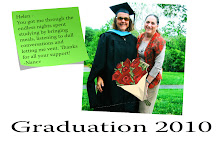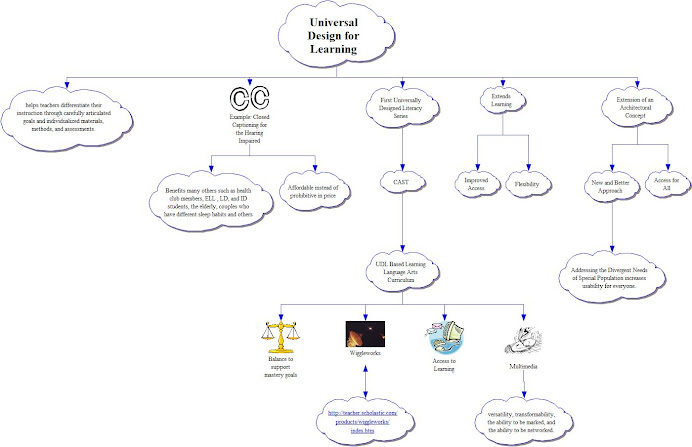Tuesday, April 21, 2009
Peer Review
Reviewing Websites and having a second set of eyes, as well as viewing our websites on a computer other than our own brings up some points that may otherwise be overlooked. The collaborative approach works again! I am hoping to fix several problems now, thanks to that time we spent in class checking each other's sites.
Sunday, April 19, 2009
Wikis and podcasts and all kinds of social networks
We really have been immersed in new technology, which is the focus, of course, that MD400 must have. I will use what I've learned as much as possible when it makes learning more relevant and when I am set up properly to do so. The major hurdles are not having the right equipment, or not having every detail of what will be correlated to the content being taught. Time is precious during the school day; we, as teachers, are responsible for making the most of every moment. Well designed technology lessons merit use in the classroom.
Saturday, March 21, 2009
Power Point is not evil
Recently, we were given instructions on how to use Excel for transferring data from an existing database to Excel spreadsheets. The Power point presentation used by the presenter had sound effects and graphics that included arrows, drum rolls and applause. I found it very helpful, especially when dealing with tiny boxes, letters and numbers. People were engaged in learning some new applications and the added humor broke the monotony nicely.
One of the most important things to know is that Power point is only a tool, which should be used as such to deliver the message intended by the person creating it.
One of the most important things to know is that Power point is only a tool, which should be used as such to deliver the message intended by the person creating it.
Saturday, March 14, 2009
ESL
My first question involving ESL was, "What is Literacy Volunteers?" I was given a brief answer by the desk attendant at the local YMCA, where I had been going to work out. "They need a new director, if you're interested", she said. "What would I have to do to apply?" I asked. "Just fill out the application form and send your resume. You can start on Monday", was the surprising answer. Little did I know what an adventure I was about to take. It was around the time of 9-11 -00, when every person of Arab descent was suspected to be a terrorist, that my first student, Mohammed, a native of Bangladesh ,with very little English, came to the office of Literacy Volunteers, seeking English language instruction. My attempt to teach him was rather intuitive and not at all orthodox, but he was able to learn quickly. Everything I did as Director was done by trial and error. Only a few people helped me, and it was very difficult . Some of the prospective students were from the U.S., with difficulties learning to read. We had to train tutors to be able to function as a volunteer organization. Therefore, I needed to be trained as a trainer. I took an online course to achieve this, and learned by doing. There was a database installed on the literacy office computer for tracking thr pairs of student-tutors who worked on learning English as a second language or on basic skills, such as writing a check. I had to meet with a Board of Directors, mail requests for donations, promote our organization, and at the same time, support the tutors and students through meetings, phone calls and assessments. Now when I look back, it was an incredible learning experience with next-to-nothing in financial rewards, but enormous benefits in terms of character-buliding, use of new technology and networking. I learned what it means to run a non-profit organization with little or no assistance. Plus, I discovered many things about myself and about the world. It was the quintessential "inquiry-based learning experience". Now I understand what English as a Second Language (ESL) means!
Monday, March 9, 2009
Power Point
After reading about differing views about Power Point in Education, I have decided that Power Point can be used creatively to do great things. On the other hand, it can be used lazily to block high level thinking. Some ideas for Power Point for ELL's are really useful because of the user-friendly format it offers them. They can produce language in a way that is non-threatening and that gives instant results that are impressive. The consistency of Power Point is comforting and lowers the affective filter. Adding sound and animation can also be interesting. We have all experienced mind-numbing Power Point presentations, read by the presenter, with very minimal imagination. This is similar to "Web Sites That Suck" - something to avoid.
Saturday, February 28, 2009
Reflections
Starting out in this course as a novice ( a rookie, a beginner ) makes it easy for me to be impressed and enthralled with all the incredible ideas for teaching via technology that are being presented in this class. I read the article, "Pay Attention" today and agree that we have to "engage, not enrage "students by meeting them where they're at: using ipods and cell phones, which are their constant companions. I do wonder why teachers cling to the old, though, rather than recognizing that texting is reading and writing and that students are bored by the traditional classroom approach.
From the very first day, with digital "tableaux", this has been a stimulating, inspiring experience - as we have been exposed to Photoshop and manipulating digital photos, reading about integrating and implementing technology, great examples for using blogging in "Teddy Bears Go Blogging, the use of Standards as we prepare our lessons, the issues about copyright law when using other people's material, the principles of Universal Design, using drama and knowing our students, I feel we have been provided with an enlightened background necessary for using technology in the classroom. It makes sense to learn about something before going out to teach students; this background knowledge is invaluable information.
From the very first day, with digital "tableaux", this has been a stimulating, inspiring experience - as we have been exposed to Photoshop and manipulating digital photos, reading about integrating and implementing technology, great examples for using blogging in "Teddy Bears Go Blogging, the use of Standards as we prepare our lessons, the issues about copyright law when using other people's material, the principles of Universal Design, using drama and knowing our students, I feel we have been provided with an enlightened background necessary for using technology in the classroom. It makes sense to learn about something before going out to teach students; this background knowledge is invaluable information.
Sunday, February 22, 2009
"Added Value"
The techniques we have been learning about this semester in MD 400 definitely have "added Value" in that they offer ways to do things that would not otherwise be possible. Sharing here in this blog is one example of how to expand the potential forum to include anyone who has a computer, rather than restricting access to just the professor, or a few people in a class. This absolutely goes along with the idea of Universal Design for Learning because it is more easily accessible. Some of the components embedded in our digital imagery manipulation for the website we are working on - such as naming our saved images (using alternate text) so that they may be understood by the visually impaired using voice technology in place of read only also broaden the horizons for sharing information with people of all learning styles.
Monday, February 16, 2009
Student Standards
Since I work with all levels of ESL students, my choice of standards for them is taken from the National TESOL standards:
"Goal 3, Standard 3 -To use English in socially and culturally appropriate ways: Students will use appropriate learning strategies to extend their sociolinguistic and sociocultural competence."
This includes using technology, of course, which expands the potential for learning tremendously. My concerns ( and those of my colleagues ) are for students to reach proficiency and to score well on the standardized tests they are required to take at school. This places demands on them to master all the aspects of language that come naturally to a native speaker of English. ELL's need intense, explicit instruction of things like idioms because they have not been exposed to all of these non-literal forms of expression.
"Goal 3, Standard 3 -To use English in socially and culturally appropriate ways: Students will use appropriate learning strategies to extend their sociolinguistic and sociocultural competence."
This includes using technology, of course, which expands the potential for learning tremendously. My concerns ( and those of my colleagues ) are for students to reach proficiency and to score well on the standardized tests they are required to take at school. This places demands on them to master all the aspects of language that come naturally to a native speaker of English. ELL's need intense, explicit instruction of things like idioms because they have not been exposed to all of these non-literal forms of expression.
It is somehow satisfying to challenge the traditional classroom approach using the ubiquitous K-W-L charts to initiate lessons with asking HOW instead - and actually digging deep and wide to find the answers. Promoting this kind of investigative work is the way to find out about things, and it will revolutionize schools when implemented. As a team player, teaching in a school district, it is very difficult to introduce new ideas for teaching. Keeping one's job is part of the very real problem with the system. If enough of us push for open classrooms, we will see the results. Our world needs thinkers and doers who are seeking answers and are not afraid to look for them.
Wednesday, February 11, 2009
Inquiry Based Learning
As a teacher of ESL, I have used inquiry based learning many times in my efforts to help adult students find information they need for their families, or for employment, or to answer a question they have. Together we have found out many times that teacher and student learn together; it is a discovery based approach - not a traditional teacher as expert model. When working with children, it has been fun to map concepts together, with surprising results for everyone involved; finding connections, sharing background knowledge expands the possibilities as students brainstorm ideas with their classmates and the teacher. Everyone contributes in this approach.
Last semester, as a graduate student, I participated in an ethnographic study of senior citizens who were also first generation immigrants. This was inquiry based, using taped interviews done in the homes of the interviewees, and in one case, a senior center. Although a fellow student and I developed the interview questions, the answers we recorded stimulated further questioning and reflection. The questions evolved and continue, making it an open-ended study.
Last semester, as a graduate student, I participated in an ethnographic study of senior citizens who were also first generation immigrants. This was inquiry based, using taped interviews done in the homes of the interviewees, and in one case, a senior center. Although a fellow student and I developed the interview questions, the answers we recorded stimulated further questioning and reflection. The questions evolved and continue, making it an open-ended study.
Monday, February 2, 2009
Focus
Identifying and locating appropriate technology is a preliminary step necessary for planning the use of technology on the classroom. That is my focus at present and will be "on-going", of course, but will lay the groundwork for scaffolding with students in the future. This is part of Standard 2 of the National Standards for Technology Education. I believe it is the most important part of the process, because a teacher needs to be thoroughly prepared when infusing visual learning with digital imagery and with Inspiration. Both of these media can be used by the teacher in planning curriculum, as well as having students become involved in projects such as concept mapping new vocabulary or categorizing words.
Saturday, January 31, 2009
Outline of Universal Design for Learning
This outline was easily made using Inspiration and includes a link to CAST's "Wiggleworks", which is a leveled reading program that incorporates the multimedia approach to learning that is accessible to all. It is the first UDL program created, and offers teachers a new opportunity to serve the needs of diverse learning styles and backgrounds of elementary students.
Thursday, January 29, 2009
manipulating digital photos
This was done with weather effects found on photoshop.com, along with shadow effects and some changes in light.
Friday, January 23, 2009
Standards
I chose National Educational Technology Standards (NETS) for teachers standard #II:
II.Planning and designing Learning Environments and Experiences
A. design developmentally appropriate learning opportunities that apply technology-enhanced instructional strategies to support the diverse needs of learners.
B. apply current research on teaching and learning with technology when planning learning environments and experiences.
C. identify and locate technology resources and evaluate them for accuracy and suitability.
D. plan for the management of technology resources within the context of learning activities.
E. plan strategies to manage student learning in a technology-enhanced environment.
II.Planning and designing Learning Environments and Experiences
A. design developmentally appropriate learning opportunities that apply technology-enhanced instructional strategies to support the diverse needs of learners.
B. apply current research on teaching and learning with technology when planning learning environments and experiences.
C. identify and locate technology resources and evaluate them for accuracy and suitability.
D. plan for the management of technology resources within the context of learning activities.
E. plan strategies to manage student learning in a technology-enhanced environment.
Sunday, January 18, 2009
Today's Learners response
If kids in middle school are learning to play games, use cell phones and i-pods, going online to IM and chat, but are restricted from doing this in school, there seems to be a gap between their real lives and their school lives. Do they need to have such a separation? Do they need to learn the basics of the three R's to be able to become literate? These are new questions for our technology-based world. Does good handwriting equal high intelligence? Do different learning styles get equitable opportunities to succeed in school? There is fear about inappropriate use of the internet that causes administrators and teachers to block sites. We are caught in a place that seeks to protect children, yet limits their potential at the same time. Do we need these controls? Knowing our students and finding out about their use of technology and meeting them where they are, to teach them on their level is vital to make learning relevant to their lives.
Response to "E-Tips"
In reading this article, I was struck by the layers of important considerations involved in deciding to implement technology in a classroom. My position in the Torrington School District requires me to move from school to school as an itinerant ESL Teacher. There are some situations that may have potential though none are easily accessible.
I have had experience in a previous position at a Community College which has ideal implementation of technology in the classroom teaching adults. All of the e-tips given were in place there, including collaboration between teachers and administrators and technical support.
As I compare the availablity of computers, the support of administration and feasibility of using computers and technology, there is a great disparity due mainly to budgetary constraints. This makes my present position precarious in terms of using technology to its fullest potential, though I plan to try to infuse as much as possible, because I have seen what it can do.
I have had experience in a previous position at a Community College which has ideal implementation of technology in the classroom teaching adults. All of the e-tips given were in place there, including collaboration between teachers and administrators and technical support.
As I compare the availablity of computers, the support of administration and feasibility of using computers and technology, there is a great disparity due mainly to budgetary constraints. This makes my present position precarious in terms of using technology to its fullest potential, though I plan to try to infuse as much as possible, because I have seen what it can do.
Teddy Bears Go Blogging Response
I remember sending home a stuffed animal with pre-school students and the very real involvement of the students when each child returned to school to share at circle time about what the bear did over the weekend. This idea of blogging about the experiences allows for so much more input by parents and siblings of the students, who are empowered by being the catalysts for all of this writing. What a wonderful way to "put learning in the hands of the students". I love the fact that a great deal of reflection can take place; it is not rushed and can be done at home or anywhere. Learning about another place like Australia expands the lesson enormously, in an unforgettable activity. For teachers, this is wonderful because it is easy and requires very little intervention. Another thought I had was that students can publish without the problem e-mail sometimes presents with lack of response. Whether people respond or not, the blog has integrity as a piece of written work.
Monday, January 12, 2009
First class - January 12, 2009
We have a full house (every computer taken) - and it's great so far using Apple computers. I am learning together with Helene, Shelley and Fabiola, familiar faces from other GSEAP classes. Our professor and the grad assistant are very helpful. This is going to be fun and challenging. We are all going to be able to teach our kids this stuff! Did a tableaux of Lord of the Flies using digital cameras. Will definitely try it ASAP at the Middle School.
Subscribe to:
Posts (Atom)


